Many mysteries surround conditions in the early Universe, chief amongst these is the question of how and when galaxies began to form. At some point in the Universe’s history, gravitational instability brought together increasingly larger clumps of matter, beginning with atoms, dust, and gas, then stars and planets, clusters and then massive galaxies.
Whilst early protogalaxies may have formed as early as a few hundred million years after the Big Bang, the first well-formed galaxies with features such as spiral arms, rings and bars are thought to have only formed around 6 billion years into the Universe’s 13.8 billion year lifetime.
Astronomy has, in general, confirmed this. With closer and thus later galaxies displaying characteristics such as rings, bars and spiral arms, like our own home, the Milky Way. Features lacking in more distant, earlier galaxies.
New discoveries, however, are challenging this accepted view, with three recent pieces of research, in particular, suggesting that well-ordered and massive galaxies existed much earlier in the Universe than previously believed. This either means that the formation of galaxies began much earlier than expected or progressed much faster than many models suggest.
As a consequence scientists may have to refine models of galaxy formation to account for much earlier or much more rapid evolution.

The key to solving the mystery of how soon after the Big Bang galaxies with definitive shapes and features such as thin discs and spiral arms formed begins with examining theories that describe this formation. One family of theories which implies these processes occur over a prolonged period of time, and another, that suggests formation can proceed much more quickly.
Bottom’s Up! Did Formation Start Earlier or Proceed Quicker?
The simplest model of galaxy formation suggests that at a time when the Universe was mostly hydrogen and helium, such structures emerged from dense clouds of gas that collapsed under their own gravity. This so-called ‘monolithic model’ was the first suggested formation process for galaxies and the stars that comprise them and is referred to as a ‘bottom-up’ or hierarchical formation model.
There are also ‘top-down’ formation models that suggest galaxies may have emerged from larger conglomerates of matter that collapsed in a similar fashion but then went on to break apart, but these currently aren’t favoured by most cosmologists.

Under the influence of gravity, gas and dust collapse into stars which are drawn together as clusters, then superclusters, and finally galaxies. The question is, how do galaxies grow and develop their characteristics?
One idea suggests that the seed of a galaxy continues to accumulate gas and dust, slowly growing to massive size. When it reaches gigantic proportions, this galaxy is able to gobble up clusters of stars and even smaller galaxies. This process should be fairly slow, however, glacially so at first, in fact, accelerating once smaller galaxies begin to be absorbed.
If this is the predominant formation mechanism for galaxies, then what we shouldn’t see in the early universe, before about 6 billion years after the Big Bang, are disc-like massive galaxies or spiral armed galaxies like the Milky Way. Further out in space and thus further back in time, irregulars galaxies and amorphous blobs should be favoured heavily. Unless that is, galactic formation got a serious head-start.
But, there is another theory of galactic evolution. What if galaxy growth progresses predominantly through merger processes?
Rather than a galaxy waiting until it grows massive in size to start accumulating its smaller counterparts, mergers between similar-sized galaxies could be the driving factor in creating larger galaxies. This would mean that the process of galaxy formation could proceed much more quickly than previously believed.
In either case, what we should see is massive galaxies well-formed with characteristics like disks, bars, and spiral arms way further out into space, and thus further back in time.
It just so happens that is exactly what astronomers are starting to find.
Should’ve Put a Ring on it!
One such line of evidence for a more rapid form of galactic formation or a much earlier start, comes in the distinctive doughnut-like shape of a collisional ring galaxy discovered 11 billion-light-years away. This means this “cosmic ring of fire” — similar in mass to the Milky Way and notable for the massive ‘hole’ in its centre which is three million times the distance between the Earth and the Sun — existed when the Universe was just 2.7 billion years old. Far earlier than predicted.
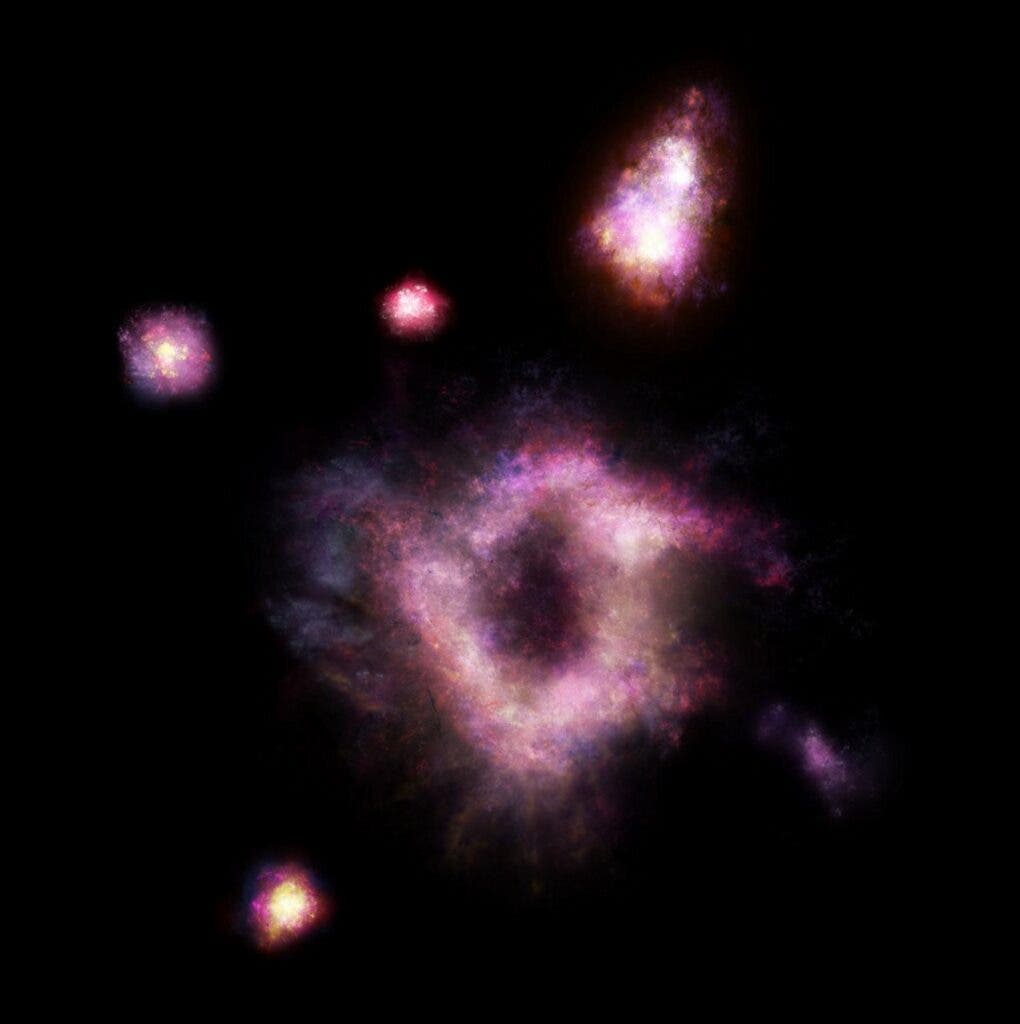
Dr Tiantian Yuan, of Australia’s ARC Centre of Excellence for All-Sky Astrophysics in 3 Dimensions (ASTRO 3D) was part of a group that successfully gave the ring galaxy — designated R5519 — an age.
“It is very a curious object, one that we have never seen before, definitely not in the early Universe,” explains Yuan, a specialist in studying galactic features like spiral arms. “R5519 looks like a corona galaxy, but it isn’t.”
So, even if R5519 is striking, how does this imply that models of galaxy evolution could be inaccurate? The answer lies in how collisional ring galaxies such as this are created.
Yuan explains that the ‘hole’ at the centre of R5519 was created when a thin disk-like galaxy was ‘shot’ by another galaxy hitting head-on, just like a bullet hitting a thin paper target at a shooting range.
“When a galaxy hits the target galaxy — a thin stellar disk — like a bullet, head-on, it causes a pulse in the disk of the victim galaxy,” Yuan says. “The pulse then induces a radially propagating density waves through the target galaxy that form the ring.”
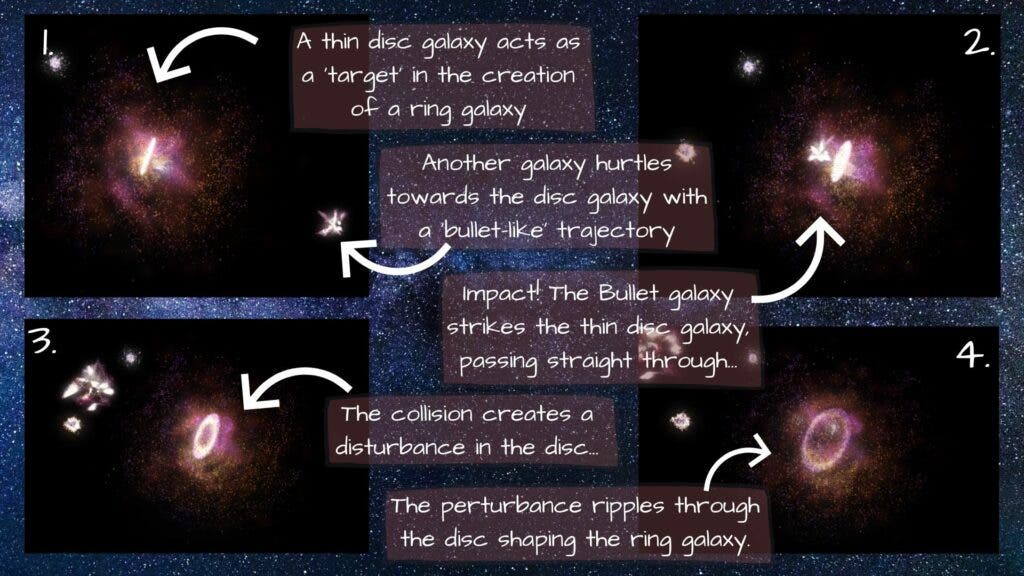
Yuan explains that at one time astronomers had expected to find more collisional ring galaxies in the young universe, simply because there were more galactic collisions progressing at that time. “We find that is not the case,” she continues. “The young universe might have more collisions and bullets, but it lacks thin stellar disks to act as targets… or so we thought.”
Here’s where the problem lies, thin stellar disks that serve as targets in this cosmic firing range aren’t supposed to exist so early in the Universe’s history according to currently favoured cosmological models.
“Our discovery implies that thin stellar disks similar to our Milky Way’s are already developed for some galaxies at a quarter of the age of the universe.”
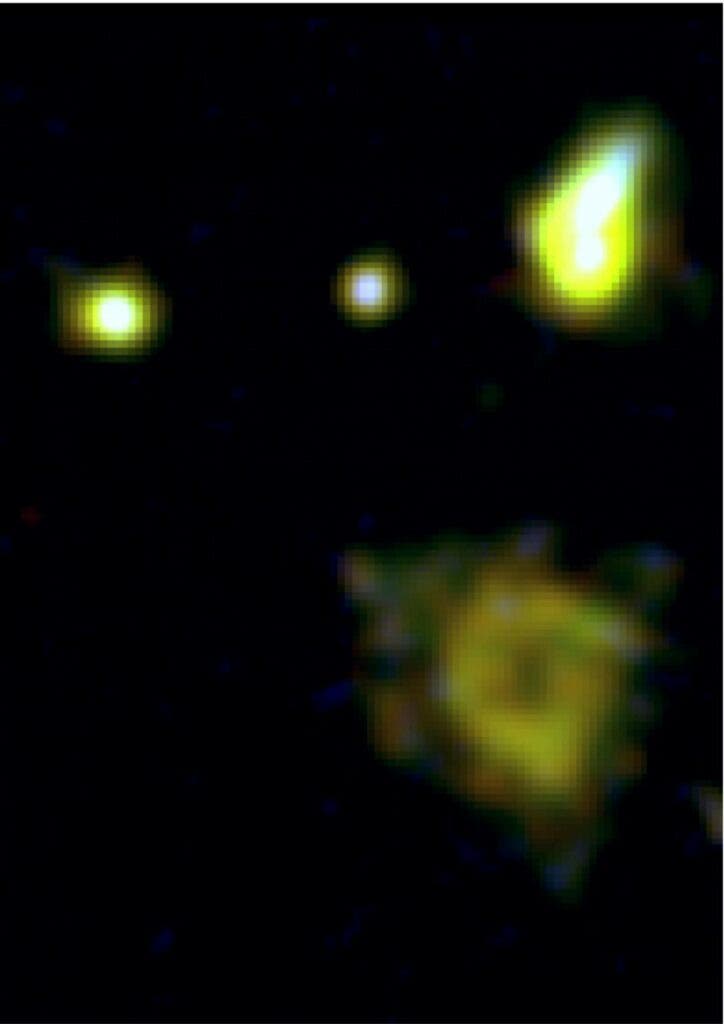
Yuan and her team’s findings show galactic structures like thin disks and rings could form 3 billion years after the Big Bang. The researcher points to another piece of research that supports the idea of structured galaxies in the early Universe.
“The first step in disk formation is to form a disk at all — an object that is dominated by rotation,” Yuan says. “This is why the recent discovery of the ‘Wolfe disk’ is truly amazing — it pushes the earliest formation time of a large gas disk to much earlier than we previously thought.”
Who’s Afraid of the Big Bad Wolfe?
The discovery Dr Tiantian Yuan refers to is the identification of a massive rotating disk galaxy when the Universe was just 1.5 billion years old. The galaxy — officially named DLA0817g — is nicknamed the ‘Wolfe Disk’ in tribute to the late astronomer Arthur M. Wolfe, who first speculated about such objects in the 1990s.
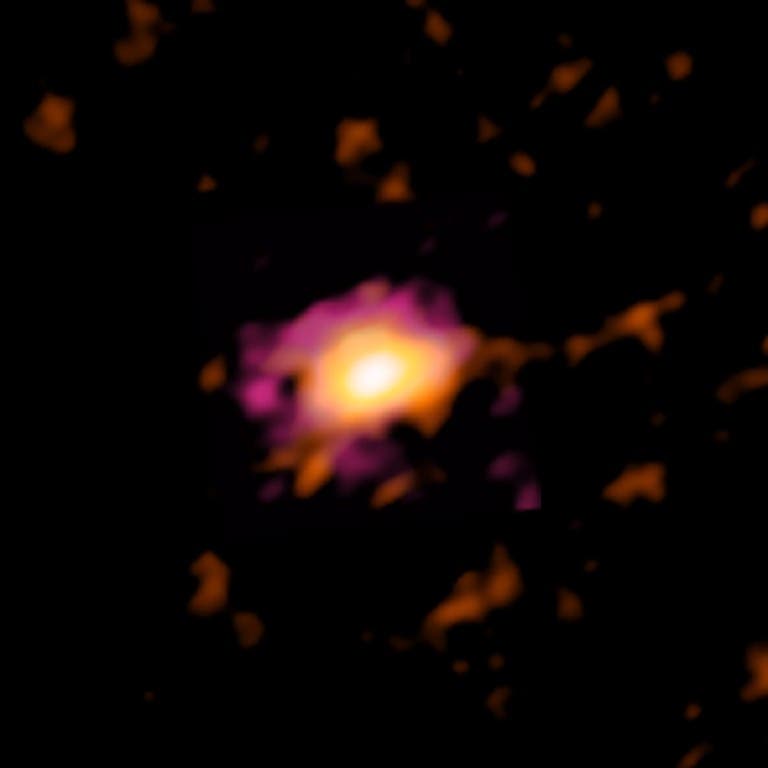
The fact that the Wolfe Disk —which is spinning at tremendous speeds of around 170 miles per second — exists when the Universe was just 10% of its current age, strongly implies rapid galactic growth or the early formation of massive galaxies.
“The ‘take-home’ message from the discovery of a massive, rapidly rotating disk galaxy that resembles our Milky Way but formed only 1.5 billion years after the Big Bang, is that galaxy formation can proceed rapidly enough to generate massive, gas-rich galaxies at early times,” says J. Xavier Prochaska, professor of astronomy and astrophysics at the University of California Sant Cruz, and part of a team that discovered the Wolfe Disk.
The team behind the Wolfe Disk discovery posit the idea that its existence and the fact that it is both massive and well-formed indicate that the slow accretion of gas and dust may not be the dominant formation mechanism for galaxies. Something much more rapid could be at play.
“Most galaxies that we find early in the universe look like train wrecks because they underwent consistent and often ‘violent’ merging,” says Marcel Neeleman of the Max Planck Institute for Astronomy in Heidelberg, Germany, who led the astronomers. “These hot mergers make it difficult to form well-ordered, cold rotating disks as we observe in our present universe.”

If the Wolfe Disk grew as the result of the accumulation of cold gas and dust, Prochaska explains that this leaves questions unanswered about its stability: “The key challenge, is to rapidly assemble such a large gas mass while maintaining a relatively quiescent, thin and rotating disk.”
Of course, sometimes it can be the absence of something that provides evidence that a theory, or family of theories is inaccurate, as the following research exemplifies.
Further away and further back in time: Some of our Stars are Missing
The Hubble Space Telescope (HST) allows astronomers to stare back in time to when the Universe was just 500 million years old, allowing researchers to finally investigate the nature of the first galaxies and could deliver more contradictions to current cosmological models just as the Wolfe Disk and R5519 have.
Results recently delivered by the HST and examined by a team of European astronomers confirm the absence of the primitive stars when the Universe was just 500 million years old.
These early stars — named Population III stars — are thought to be composed of just hydrogen and helium, with tiny amounts of lithium and beryllium, reflecting the abundances of these elements in the young Universe.
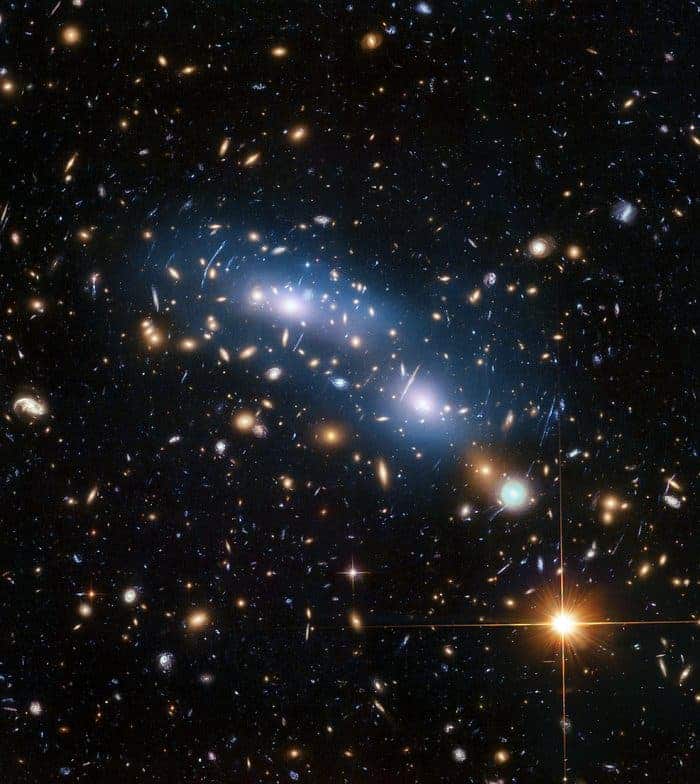
A team of astronomers led by Rachana Bhatawdekar of the European Space Agency confirmed the absence of this first generation of stars by searching the Universe as it existed between 500 million years to 1 billion years into its history. Their observations were published in a 2019 paper with further research due to publish in Monthly Notices of the Royal Astronomical Society as well as being discussed at a press conference during the 236th meeting of American Astronomical Society.
“Population III stars are extremely hot and massive and so they are much bluer in colour than normal stars,” Bhatawdekar says. “We, therefore, looked at the ultraviolet colours of our galaxies to see exactly how blue they looked.”
The team found even though the galaxies they observed were blue, they weren’t blue enough to have stars with very low metals–by which, astronomers mean any element heavier than hydrogen and helium, such as oxygen, nitrogen, carbon, iron etc…
“What this tells us is that even though we are looking at a Universe that is just 500 million years old, galaxies have already been enriched by metals of significant amount,” Bhatawdekar. “This essentially means that stars and galaxies must have formed even earlier than this very early cosmic time.”
Thus the team’s observations imply that stars had already begun to fade and die by this point in time, shedding heavier elements back into the Universe. These elements would go on to form the building blocks of later generations of stars.
This piece of the puzzle would seem to suggest that the presence of massive galaxies is not a factor that arises as the result of rapid growth, but that the growth processes began earlier.
“We found no evidence of these first-generation Population III stars in this cosmic time interval,” explains Bhatawdekar. “These results have profound astrophysical consequences as they show that galaxies must have formed much earlier than we thought.”
Finding More Evidence of Early Galaxy Formation
For Bhatawdekar the further investigation on conditions in the early Universe will only really open up with the launch of the James Webb Space Telescope.
“Whilst we found is that there is no evidence of existence of Population III stars in this comic time but there are many low mass/faint galaxies in the early Universe,” she says. “This suggests that the first stars and first galaxies must have formed even earlier than this incredible instrument Hubble can probe.
“The James Webb Space Telescope, which is scheduled to be launched next year in 2021, will look even further back in time as far as when the Universe was just 200 million years old.”
Even before the launch of the James Webb Space Telescope, and as if to dismiss the idea that these results could be a fluke and thus not indicative of a wider shift towards earlier massive galaxies, Tiantian Yuan describes further findings yet to be published.
“I have actually found more collisional ring galaxies in the early universe!” exclaims Yuan. “There is a cool one that is gravitationally lensed, giving us a sharper view of the ring.
“I can tell you that this new ring is 1 billion years older than R5519, and it looks a lot different from R5519 and more like rings in our nearby Universe.”
As we refine our ideas of galaxy evolution we are likely to find that when presented with two conflicting theories, the truth is that which lies somewhere in-between. Thus, as we observe the formation of galaxies currently progressing, the mergers between galaxies, and complex structures in the Universe’s history we may find that galactic evolution may progress both slowly and quickly.
Hopefully, this mix of models will also deliver an accurate recipe for how spiral arms, rings, and bars arise from thin disks. Something currently lacking.
“What these discoveries mean is that we are entering a new era that we can ask the question of how different structures of galaxies first formed,” Yuan explains. “Galaxies do not form in one go; some parts were assembled first and others evolved later.
“It is time for the models to evolve to the next level of precision and accuracy. Like a jigsaw puzzle, the more pieces we reveal in observations, the more challenging it is to get the theoretical models correct, and the closer we are to grasp the mastery of nature.”
Sources and further reading
Yuan. T, Elagi. A, Labbe. I, Kacprzak. G. G, et al, ‘A giant galaxy in the young Universe with a massive ring,’ Nature Astronomy, [2020].
Neeleman. M, Prochaska. J. X, Kanekar. N, Rafelski. M, [2020], ‘A cold, massive, rotating disk galaxy 1.5 billion years after the Big Bang,’ Nature, [https://www.nature.com/articles/s41586-020-2276-y]
Bhatawdekar. R, Conselice. C. J, Margalef-Bentabol. B, Duncan. K, ‘Evolution of the galaxy stellar mass functions and UV luminosity functions at z = 6−9 in the Hubble Frontier Fields,’ Monthly Notices of the Royal Astronomical Society, Volume 486, Issue 3, July 2019, Pages 3805–3830, [2019], https://doi.org/10.1093/mnras/stz866


